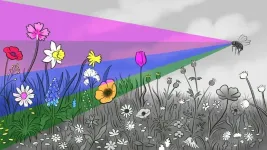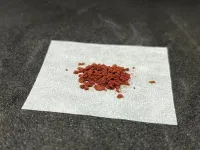(Press-News.org) NEW YORK, NY — Perceiving something – anything – in your surroundings is to become aware of what your senses are detecting. Today, Columbia University neuroscientists identify, for the first time, brain-cell circuitry in fruit flies that converts raw sensory signals into color perceptions that can guide behavior.
Their findings were pulbished in the journal Nature Neuroscience.
“Many of us take for granted the rich colors we see every day – the red of a ripe strawberry or the deep brown in a child’s eyes. But those colors do not exist outside of our brains,” said Rudy Behnia, PhD, a principal investigator at Columbia's Zuckerman Institute and the corresponding author on the paper. Rather, she explained, colors are perceptions the brain constructs as it makes sense of the longer and shorter wavelengths of light detected by the eyes.
“Turning sensory signals into perceptions about the world is how the brain helps organisms survive and thrive,” Dr. Behnia said.
“To ask how we perceive the world seems like a simple question, but answering it is a challenge,” added Dr. Behnia “My hope is that our efforts to uncover neural principles underlying color perception will help us better understand how brains extract the features in the environment that are important for making it through each day.”
In their new paper, the research team reports discovering specific networks of neurons, a type of brain cell, in fruit flies that respond selectively to various hues. Hue denotes the perceived colors associated with specific wavelengths, or combinations of wavelengths of light, which themselves are not inherently colorful. These hue-selective neurons lie within the optic lobe, the brain area responsible for vision.
Among the hues these neurons respond to are those that people would perceive as violet and others that correspond to ultraviolet wavelengths (not detectable by humans). Detecting UV hues is important for the survival of some creatures, such as bees and perhaps fruit flies; many plants, for example, possess ultraviolet patterns that can help guide insects to pollen.
Scientists had previously reported finding neurons in animals’ brains that respond selectively to different colors or hues, say, red or green. But no one had been able to trace the neural mechanisms making this hue selectivity possible.
This is where the recent availability of a fly-brain connectome has proven helpful. This intricate map details how some 130,000 neurons and 50 million synapses in a fruit-fly’s poppy seed-sized brain are interconnected, said Dr. Behnia, who is also an assistant professor of neuroscience at Columbia’s Vagelos College of Physicians and Surgeons.
With the connectome serving as a reference – akin to a picture on a puzzle box serving as a guide for how a thousand pieces fit together – the researchers used their observations of brain cells to develop a diagram they suspected represents the neuronal circuitry behind hue selectivity. The scientists then portrayed these circuits as mathematical models to simulate and probe the circuits’ activities and capabilities.
“The mathematical models serve as tools that enable us to better understand something as messy and complex as all of these brain cells and their interconnections,” said Matthias Christenson, PhD, a co-first author on the paper and a former member of Dr. Behnia’s lab. “With the models, we can work to make sense of all of this complexity.” Also contributing crucially to the modeling work was Dr. Larry Abbott, William Bloor Professor of Theoretical Neuroscience, Professor of Physiology and Cellular Biophysics and a principal investigator at the Zuckerman Institute.
Not only did the modeling reveal that these circuits can host activity required for hue selectivity, it also pointed to a type of cell-to-cell interconnectivity, known as recurrence, without which hue-selectivity cannot happen. In a neural circuitry with recurrence, outputs of the circuit circle back in to become inputs. And that suggested yet another experiment, said Álvaro Sanz-Diez, PhD, a postdoctoral researcher in Dr. Behnia’s lab and the other co-first author of the Nature Neuroscience paper.
“When we used a genetic technique to disrupt part of this recurrent connectivity in the brains of fruit flies, the neurons that previously showed hue-selective activity lost that property,” said Dr. Sanz-Diez. “This reinforced our confidence that we really had discovered brain circuitry involved in color perception.”
“Now we know a little more about how the brain’s wiring makes it possible to build a perceptual representation of color,” said Dr. Behnia. “My hope is that our new findings can help explain how brains produce all kinds of perceptions, among them color, sound and taste.”
###
The paper, “Hue selectivity from recurrent circuitry in Drosophila,” was published online in Nature Neuroscience on May 16, 2024.
The full list of authors includes Matthias Christenson, Álvaro Sanz-Díez, Sarah L. Heath, Maia Saavedra-Weisenhaus, Atsuko Adachi, Aljoscha Nern, Laurence F. Abbott and Rudy Behnia.
The authors declare no competing interests.
END
After spinning for under two years, a wind farm can offset the carbon emissions generated across its entire 30-year lifespan, when compared to thermal power plants.
That’s according to a new peer-reviewed study published in the Journal of the Royal Society of New Zealand – which also shows within six months a turbine can generate all the energy consumed across its life-cycle.
The research uses data from the Harapaki onshore wind farm in Hawke’s Bay, New Zealand – however the authors of the paper explain that their findings would be replicated across most, if not all, wind farms internationally.
“The wind turbine technology employed in New Zealand ...
One in three people around the world die from cardiovascular disease, which is mainly caused by atherosclerosis. This makes atherosclerosis the leading cause of death globally. Additionally, many people live with serious manifestations of atherosclerosis, for example, following a heart attack or a stroke.
Atherosclerosis not only represents a significant burden for these individuals, but also a heavy burden on healthcare systems and societies in all parts of the world.
“Atherosclerosis may develop from an early age and often remains 'silent’, that is, without symptoms, ...
While ethanol in alcoholic beverages impairs drinkers’ motor functions, it is that same substance that can power motor vehicles in a cleaner, more sustainable manner. What is necessary for the production of ethanol is yeast, but ethanol is among the environmental factors that add stress to yeasts, hindering their growth. To promote efficient bioethanol production, scientists have been searching for substances that can help yeasts better withstand ethanol, but few effective ones have been found.
An Osaka Metropolitan ...
Fukuoka, Japan—Researchers at Kyushu University have published a comprehensive analysis on the carbon footprint of constructing a wooden house in Japan. The study covered the total amount of emissions produced, taking into consideration the entire supply chain including the processing and transport of the raw materials that go into building a house.
The team hopes that by identifying emission hot spots in the supply chain that go into building a house, policy makers can implement strategies to reduce its climate impact. Their analysis was published in the Journal of Environmental ...
Scientists at the University of Oregon have discovered that colonies of gelatinous sea animals swim through the ocean in giant corkscrew shapes using coordinated jet propulsion, an unusual kind of locomotion that could inspire new designs for efficient underwater vehicles.
The research involves salps, small creatures that look similar to jellyfish that take a nightly journey from the depths of the ocean to the surface. Observing that migration with special cameras helped UO researchers and their colleagues capture the macroplankton’s graceful, coordinated swimming behavior.
“The largest migration on the planet ...
New research led by Flinders University and international experts is expanding understanding of vaccine-induced immune thrombocytopenia and thrombosis (known as VITT).
At the height of the COVID-19 pandemic in 2021,VITT emerged as a new disease following adenovirus vector-based vaccines – notably the Oxford-AstraZeneca vaccine.
VITT was found to be caused by an unusually dangerous blood autoantibody directed against a protein termed platelet factor 4 (or PF4).
In separate research in 2023, ...
BATON ROUGE – Ochsner Baton Rouge has opened the new Ochsner Outpatient and Home Infusion Pharmacy – Baton Rouge at 4730 Bluebonnet Blvd., Suite 401. This advanced facility provides treatment for chronic, specialty and acute home infusions.
The pharmacy is conveniently located and designed with patient comfort and accessibility in mind. Each of its six patient rooms offers a spa-like environment, providing patient care in a peaceful, supportive setting that promotes healing. Ochsner’s pharmacists work closely with patients’ healthcare providers to create customized treatment plans, ensuring personalized and effective ...
Key takeaways
A new study by UCLA sociologists found that using the word “please” does not always indicate respect or politeness.
In the study, “please” was used only 7% of the time, mostly when there was an inhospitable interactional environment to overcome.
Findings will help researchers in their understanding of politeness in the flow of social behavior and norms.
By kindergarten age, most children have been taught that “please” is a magic word. “Please” is an expression of politeness that shows courtesy and respect, turning a potential demand into a request that will – ...
The Davos Alzheimer’s Collaborative (DAC), the organization leading an unprecedented global response to Alzheimer’s, today announced the first-ever brain health and dementia conference in Africa, held in Nairobi, Kenya from September 11-12 in partnership with Nature Conferences and the Aga Khan University’s Brain & Mind Institute. The conference, “The Future of Dementia in Africa: Advancing Global Partnerships,” focuses on scientific advancements in understanding the impact of dementia, risk ...
Climate change, and its effects on weather patterns and adverse weather events, is likely to negatively affect the health of people with brain conditions, argue a UCL-led team of researchers.
In a Personal View article, published in The Lancet Neurology, the team emphasise the urgent need to understand the impact of climate change on people with neurological conditions – in order to preserve their health and prevent worsening inequalities.
Following a review of 332 papers published across the world between 1968 and 2023, the team, led by Professor Sanjay Sisodiya (UCL Queen Square Institute of Neurology), said they expect the scale of the potential ...






